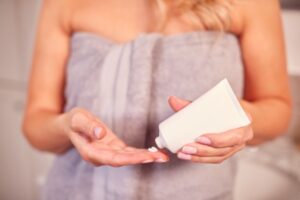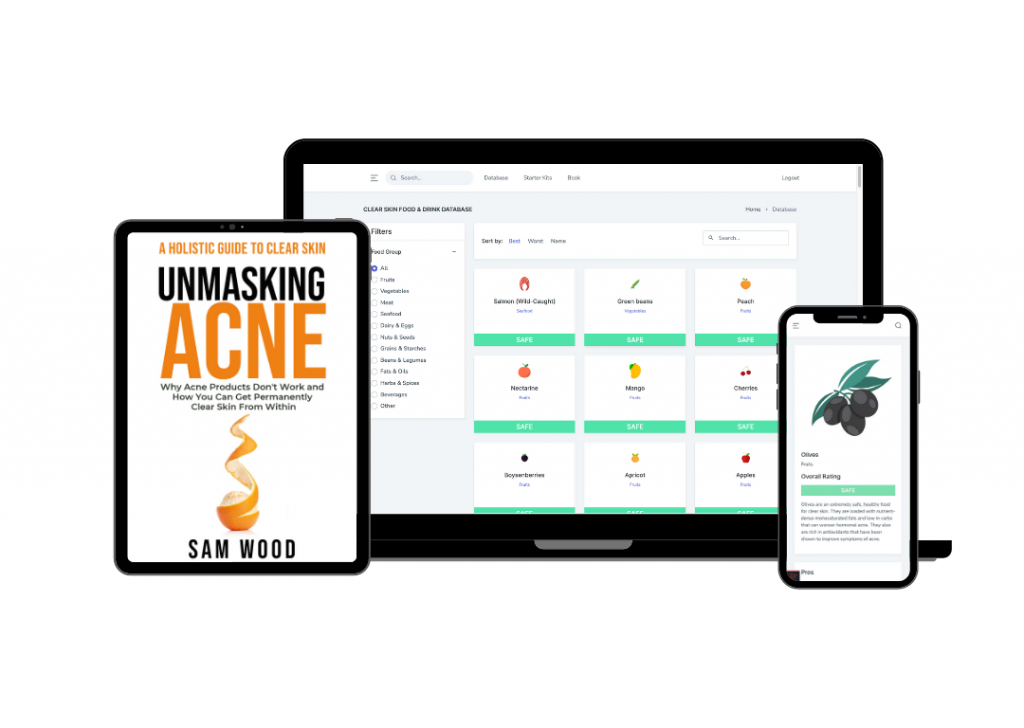Mupirocin, also known as pseudomonic acid A is a topical antibiotic cream or ointment that works by preventing the growth of specific bacteria. Although it is typically not the first acne vulgaris treatment that is recommended by dermatologists, mupirocin can help alleviate bacterial acne breakouts by prohibiting the growth of unwanted bacteria.
This article will give an overview of when Mupirocin should be prescribed for acne, its effectiveness, common side effects to look out for and alternatives with less risk.
When Should Mupirocin Be Used For Acne Treatments?
Mupirocin will only be used as a treatment for your acne if your doctor believes there is a secondary bacterial infection in your skin. Acne is ultimately an infection of your skin, and when a pimple ruptures the chances of a bacterial skin infection go up dramatically. This infection can cause your acne to spread and worsen or even term into something life threatening like a staph infection or or MRSA.
If your doctor is concerned that a bacterial infection is growing on your skin they may prescribe Mupirocin to prevent the growth of further bacteria before your acne turns cystic. Bacteria can occasionally cause acne, and mupirocin is an antibiotic. This simply means that mupirocin is a medication that fights, kills or prevents the growth of bacteria, including the ones that cause acne.
Mupirocin contains certain acids that target the component responsible for multiplying bacteria. Mupirocin hinders the ability of this component, which in turn prevents the spread of the bacteria. This process will help kills severe bacterial acne, prevents incoming acne, and mitigate the potential of acne scarring.
It is essential to know that the success of mupirocin for acne varies among people. It may work for some while it won’t work for others. The good news is that most people who use mupirocin for pimples are happy with the result (however this is because you must see a doctor to have it prescribed, so if your are taking it, then a medical professional believes it will work).
Unfortunately, this result can sometimes be short-lived as bacteria can become antibiotic-resistant. You may also be faced with disturbing side effects, which is why you have to consult a healthcare professional to help you weigh the pros and cons of this drug.
How Long Can Mupirocin Be Taken For Acne Breakouts?
Mupirocin is typically taken for 10-15 days. However, the proper timeframe for every individual can be slightly different so always check with your doctor before starting or discontinuing use.
Prolonged use of mupirocin is not advised as it can lead to the rise of new fungi or bacteria that are resistant to mupirocin, including a more severe, bacterial form of acne. So you have to ensure you don’t take mupirocin ointment for acne or any other skin infection longer than prescribed.
3 Most Common Types of Mupirocin For Acne
The three most common types of Mupirocin are Bactroban, Centany, and Bactroban Nasal. However, if dealing with an acne breakout doctors would normally only prescribe Bactroban or Centany.
- Bactroban
The most popular brand of Mupirocin, comes in the form of a topical antibiotic ointment. It is frequently used for bacterial skin infections like Staphylococcus (staph infections). Bactroban contains 2% mupirocin-free acid in an oil and water-based emulsion.
- Centany
Centany contains 20 mg of mupirocin, oleyl alcohol, castor oil, hard fat and propylene glycol monostearate. Centany Mupirocin ointment is for external use only. It is also safe for people between 2 months to 16 years old.
- Bactroban Nasal
Bactroban nasal is a type of mupirocin that is administered through the nose with the help of a tube. This type of Bactroban is used to fight drug-resistant bacteria in the nose (usually MRSA). Bactroban nasal (mupirocin) contains 2.15% mupirocin calcium, paraffin and a mixture of glycerin esters.
What is Mupirocin Used For Outside of Acne?
Mupirocin is used;
- To kill specific bacteria or prevent their growth and spread
- To treat bacterial skin infections
- The removal of Methicillin-resistant Staphylococcus aureus (MRSA) from the nose.
- The treatment of acne
- To treat infections caused by antibiotic-resistant bacteria
4 Steps to properly administer Mupirocin
Here’s a step-by-step way to use mupirocin for treating acne.
- Wash your hands thoroughly with soap and water.
- Wash and dry the affected area.
- Apply a small amount to the affected area using a clean cotton swab.
- Cover the area with a sterile gauze dressing or bandage. This isn’t completely necessary, so only do it if you are comfortable.
Whether the mupirocin ointment is for acne or any other skin infection, you are to use mupirocin as directed by the doctor or healthcare professional. Most times, mupirocin is prescribed to be used thrice a day for ten days.
By the fifth day, you should have begun to see improvements, and if you haven’t, don’t hesitate to reach out to your doctor.
What are the side effects of Mupirocin?
Mupirocin has several side effects that can occur when in use. Some of these side effects will require you to seek medical attention and stop using the medication immediately. The common side effects of mupirocin include the following;
- Mild burning/stinging and irritation
- Developing blisters, rash, and itching
- Reddening and swelling of your skin
- Pain and tenderness
- Having cracked, or dry skin
Although these side effects are common, you are advised to see your doctor if these side effects don’t disappear after a couple of days or if they get worse.
Rare or uncommon side effects of mupirocin include canker sores, ulcers or white spots in the mouth, tongue or lips, dizziness, Hive-like swellings on various body parts,fever, shortness of breath, and exhaustion
Another rare side effect of mupirocin is a critical intestinal condition caused by a bacteria called C. difficile. Symptoms of this condition are blood or mucus in stool, non-stop diarrhea, stomach pain or cramping.
Although uncommon, some people can get an allergic reaction to this medication. The telltale signs of an allergic reaction are itchy/swelling tongue or throat, extreme dizziness, rashes, and difficulty breathing.
Are there any medications Mupirocin cannot be combined with?
Yes, there are several medications that cannot be combined with mupirocin because the outcome could be disastrous. These medications include:
- Warfarin
- Phenprocoumon
- Fluindione
- Oxymetazoline
- Estetrol
- Acenocoumarol
- Dicoumarol
There are other medications that shouldn’t be combined with mupirocin. So when your doctor is administering this drug, make sure to let them know what other medications you are currently on.
6 Alternatives to Mupirocin for acne
Let’s mention some of the best alternatives to mupirocin and the kind of skin issues they treat.
Neosporin
Neosporin, unlike mupirocin, is an over-the-counter antibiotic. Neosporin is an ointment that prevents bacteria from entering the body through open wounds, cuts, scrapes and burns. It prevents the bacteria from causing infections in the body.
Neosporin keeps the surface of the wound clean and protected. Neosporin can also be used for a rash, but that depends greatly on the type.
Some believe that Neosporin helps with acne. This notion isn’t entirely true because Neosporin soothes the redness and inflammation that comes with acne but doesn’t cure the acne.
Benzoyl Peroxide
Benzoyl peroxide can help treat bacterial acne by clearing out the pores and oxidizing the skin. It will also strip the skin of facial oils which makes your pores less likely to clog. However, benzoyl peroxide can be harsh, especially on sensitive skin. Benzoyl Peroxide can cause peeling, irritation, and dryness, so it is best used as an occasional spot treatment instead of a regular part of your nightly routine.
Retinol
Retinol is a vitamin A derivative that can be purchased over the counter or in stronger prescription doses like Tretinoin. The primary purpose of retinol (and all topical retinoids) is to increase skin cell turnover, which most people use as an effective treatment for reducing acne breakouts. For a standard acne breakout retinol is significantly more effective than Mupirocin, however if your acne is accompanied by a bacterial infection or turns into cystic acne your doctor may prescribe Muripcoin instead.
Benyzamycin
This is a topical antibiotic treatment specifically designed to combat acne breakouts. It contains benzoyl peroxide and erythromycin, which not only treats acne but also decreases antibiotic resistance risk. Although this combination therapy is a highly effective topical acne medication it can cause dryness, peeling, and sun sensitivity.
Cleocin
Cleocin or clindamycin is a topical antibiotic cream, which, just like mupirocin, works by hampering the growth of bacteria. However, it has been know to cause skin irritation for people with sensitive skin.
Vancocin
Vancocin is used as a treatment for complicated skin infections, meningitis caused by methicillin-resistant Staphylococcus aureus and other bacterial infections.
What is Mupirocin used for outside of acne?
Mupirocin is primarily used to treat Impetigo, mild skin inflammation, methicillin-resistant bacteria in the nose, boils, and inflamed hair follicles. Although it can be used as a treatment for bacterial acne this is not the primary condition Mupirocin is targeted towards
If you are wondering what Impetigo is, let’s explain. Impetigo is a skin infection that is extremely contagious and usually affects children and infants. The main symptom of Impetigo is the development of crusty yellow growths near the mouth and other parts of the body. These growths tend to spread really fast to other areas of the body.
Frequently Asked Questions
Your skin should start looking and feeling better within the first few days of use. The results should be very noticeable by day 10.
Mupirocin helps soothe inflammation, which eventually slows down the development and appearance of scars.
It all depends on what you plan to treat. Although both are antibiotics, mupirocin is a doctor-recommended medication that’s best for acne, Impetigo, and other bacterial infections. Neosporin is best for cuts, scrapes and open wounds.
Although Mupirocin is an antibiotic there is no evidence to there is no clinical research that suggests Mupirocin can alter hormone levels. Typically, antibiotics that alter hormones are taken orally, and Mupirocin is applied topically.
So the answer to the initial question is yes, mupirocin does help acne. Acne affects about 9.4% of the population, and this is why people are always searching for a cure for it. If you don’t want to use mupirocin for acne, another thing that can have a significant effect on your acne is your diet.
Your diet and lifestyle play a massive role in the occurrence of acne. If you want to get clear skin by having the correct type of diet and lifestyle, this ebook is here to help you.
It contains every resource you need to take your skin to another level through a healthy diet.

